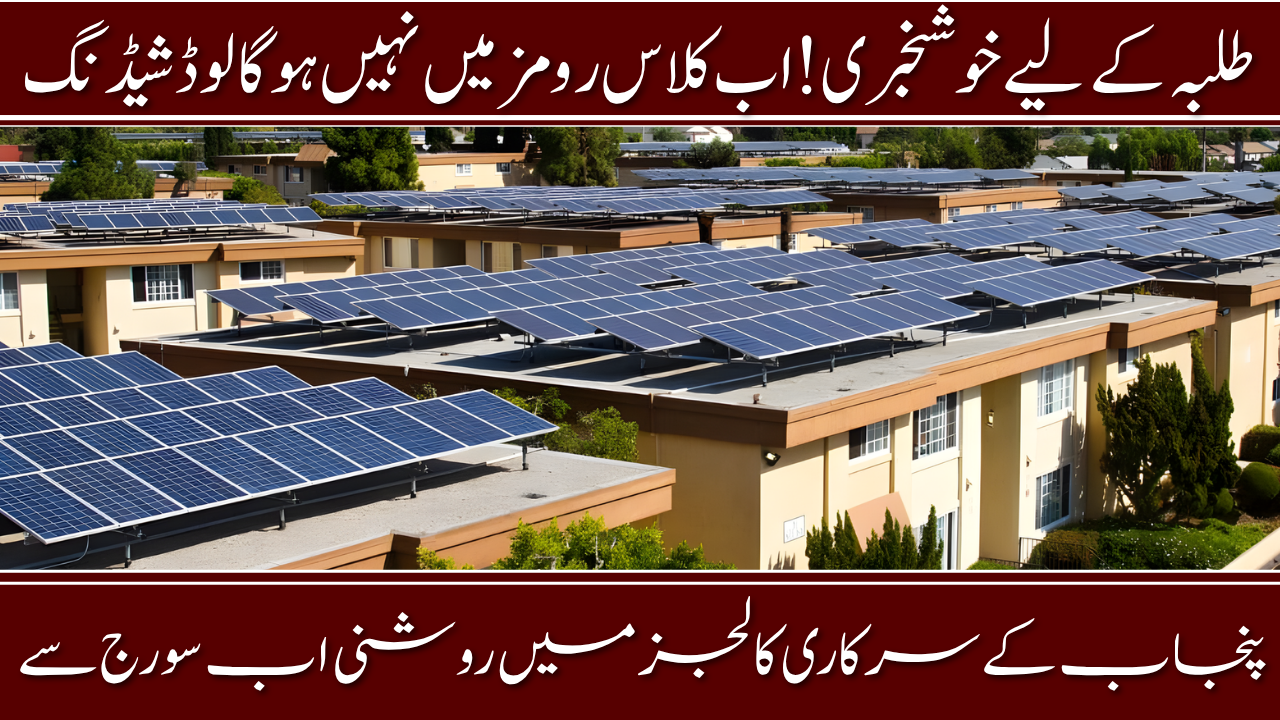Solarize Hundreds of Govt Colleges
Solarize Hundreds of Govt Colleges: The Government of Punjab has taken another major step toward sustainable development by announcing a large-scale project to solarize hundreds of government colleges across the province. This initiative not only promises to reduce the financial burden on educational institutions but also highlights the province’s growing commitment to renewable energy and climate-friendly policies.
Why Solarization of Colleges Matters
Punjab is home to thousands of students studying in government colleges. These institutions often face high electricity costs, frequent load shedding, and a lack of resources to invest in modern energy solutions. By switching to solar power, the government aims to address these challenges while ensuring uninterrupted power supply for classrooms, laboratories, and administrative blocks.
The solarization drive will also contribute to reducing carbon emissions, aligning with Pakistan’s broader climate goals and commitments to cleaner, greener energy sources.
Key Features of the Solarization Project
According to official statements, the solarization program will cover hundreds of government colleges in both urban and rural areas. Below are the major highlights:
| Aspect | Details |
|---|---|
| Target Institutions | Over 500 government colleges in Punjab |
| Energy Source | Grid-tied and standalone solar power systems |
| Expected Savings | Up to 40% reduction in annual electricity bills |
| Project Timeline | Phased completion over the next 2 years |
| Implementation | Public-private partnerships and provincial funding |
This table shows that the government is not only thinking about cost reduction but also ensuring long-term energy sustainability in educational institutions.

How to Apply
- The project is primarily government-initiated, so there is no typical “open application form” for individual colleges to apply themselves in many cases. The relevant departments take up the rollout.
- If your college is to be included, the college administration should coordinate with the relevant government department (likely the Punjab Energy Development Agency / the Provincial Higher Education Department).
- The college will likely need to:
- Provide details of the institution (name, address, electricity consumption, roof size etc)
- Provide site survey data (structural strength, roof orientation, shading)
- Agree to terms of installation/maintenance (as per vendor contracts)
- The government then issues a notification or memorandum and selects batches of colleges for the programme rollout.
- Once selected, installation is carried out by authorised vendors under contract, with maintenance arrangements and operational monitoring.
Benefits for Students and Teachers
One of the biggest advantages of this project will be uninterrupted electricity in classrooms and labs. Students preparing for exams or conducting practical work in science laboratories will benefit from a stable energy supply. Teachers will also find it easier to integrate digital tools such as projectors, smart boards, and computers into their lectures without worrying about sudden power cuts.
Moreover, colleges will be able to save money that was previously spent on electricity bills and divert it toward academic development, scholarships, and infrastructure upgrades.
Promoting Renewable Energy Awareness
Another unique feature of this project is its role in spreading awareness about renewable energy among young people. With solar panels installed in their institutions, students will get a first-hand look at how clean energy works. This will encourage them to adopt similar practices at home and in future careers, creating a culture of sustainability.
Colleges will also be able to include renewable energy as a practical subject of discussion, linking academic learning with real-life applications.
Addressing Challenges
While the solarization project has been widely praised, some experts have pointed out potential challenges. These include the high upfront cost of solar panels, the need for proper maintenance, and the availability of skilled technicians. To counter this, the government has announced partnerships with private companies specializing in solar technology. Additionally, training programs for college staff and students will be introduced to ensure proper handling and upkeep of solar systems.

Long-Term Economic Impact
The economic benefits of this project go far beyond individual colleges. By reducing dependency on the national power grid, Punjab will ease pressure on its electricity supply system. The saved energy can be diverted to households and industries that need it most.
Furthermore, the project is expected to create new job opportunities in the solar energy sector. From installation technicians to system maintenance staff, many new employment avenues will open, supporting the government’s vision of economic growth through green initiatives.
A Model for Other Provinces
Punjab’s solarization of colleges could serve as a model for other provinces in Pakistan. If implemented successfully, similar projects can be replicated in schools, universities, and hospitals across the country. This would not only strengthen Pakistan’s renewable energy footprint but also reduce reliance on expensive fossil fuels.
Conclusion
The decision to solarize hundreds of Solarize Hundreds of Govt Colleges is more than just an energy-saving initiative — it is a step toward empowering education, protecting the environment, and building a sustainable future. By combining modern technology with educational infrastructure, the government is ensuring that the next generation of students grows up with a stronger understanding of renewable energy and environmental responsibility.
As this project rolls out in the coming years, its success could inspire a nationwide shift toward clean energy solutions, proving that Pakistan’s educational institutions can lead the way in climate-friendly progress.












